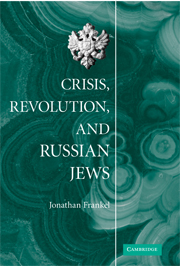Book contents
- Frontmatter
- Contents
- Acknowledgments
- Introduction
- PART I NEW DYNAMICS?
- PART II REVOLUTION AND WAR (1905–1921)
- PART III IDEOLOGICAL CONFLICT AND CONTINUITY
- PART IV OVERSEAS
- 8 The “Yizkor” Book of 1911: A Note on National Myths in the Second Aliya
- 9 The Bundists in America and the “Zionist Problem”
- PART V HISTORY AND THE HISTORIANS
- Index
8 - The “Yizkor” Book of 1911: A Note on National Myths in the Second Aliya
Published online by Cambridge University Press: 07 August 2009
- Frontmatter
- Contents
- Acknowledgments
- Introduction
- PART I NEW DYNAMICS?
- PART II REVOLUTION AND WAR (1905–1921)
- PART III IDEOLOGICAL CONFLICT AND CONTINUITY
- PART IV OVERSEAS
- 8 The “Yizkor” Book of 1911: A Note on National Myths in the Second Aliya
- 9 The Bundists in America and the “Zionist Problem”
- PART V HISTORY AND THE HISTORIANS
- Index
Summary
How nationalistic did the labor movement founded by the young Jewish immigrants to Palestine (the Second Aliya, as it is often called) become during its first decade, 1904–1914? This is a question of great importance in the history of Zionism.
After all, the small remnant of the Second Aliya which was still in Palestine in the early 1920s succeeded to a remarkable extent in stamping its mark on the fast-growing Jewish population, organizationally (through the Histadrut, the Hagana, the kibbutzim, the moshavim); ideologically (with its concept of labor hegemony); and culturally (with its strongly secular but also strongly national ethos). Veterans of the Second Aliya attained positions of political dominance both in Palestinian Jewry (the Yishuv) and in the World Zionist Organization from the 1930s. At critical moments – in 1937 (at the time of the Peel Commission), in 1947–49 (when the Jewish State was created amidst turmoil and battle) and in 1967 (following the June War) – a crucial role was played by leaders who had arrived as very young men even before 1914. Some, Berl Katznelson and Levi Eshkol, for example, were at the center of affairs during only one of these crises; but others (most notably, Yitzhak Tabenkin and David Ben Gurion) were, astonishingly, on the public stage during all three.
- Type
- Chapter
- Information
- Crisis, Revolution, and Russian Jews , pp. 183 - 215Publisher: Cambridge University PressPrint publication year: 2008



